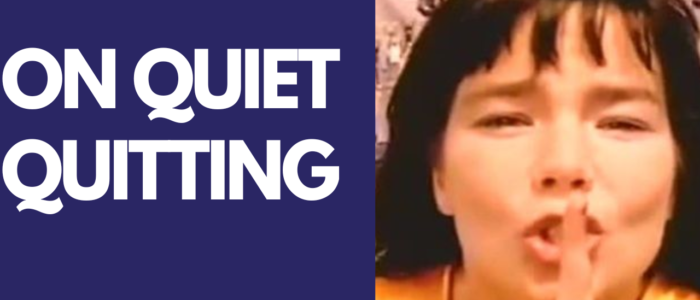On Quiet Quitting
As of writing, quiet quitting has been a bit of a hot topic.
There are many stances and opinions on it, but there’s also a lot of confusion around it. No due in part to the term “quiet quitting”, which I’m not exactly a fan of. This gives me a chance to feature Bjork.
Well, beggars can’t be choosers, and quiet quitting is what people know.
So let’s take a closer look at what quiet quitting means, some findings and stats on the topic, the implications it has in the workplace, and to your organization.
What we’ll be looking at in this article
- What is Quiet Quitting?
- Why is Quiet Quitting Being Discussed Now?
- The Problems with Quiet Quitting
- Quiet Firing: The Other Side of the Coin
- What to do About Quiet Quitting
1. What is Quiet Quitting?
Quiet Quitting caught on due to a viral video on…*sigh*…TikTok.
To say I’m not a fan of TikTok and that it’s causing the world to suffer a further drop in IQ and attention span is an understatement.
That is besides the point of this article though…here is the video.
@zaidleppelin On quiet quitting #workreform ♬ original sound – ruby
From an article from BBC Worklife on the topic of quiet quitting:
I’m not a huge fan of the term because it can easily cause confusion (I wasn’t clear what it was at first), but it’s what has caught on.
However, it’s different than the anti-work movement which popped up over the last year, and there are differences in regards to say, slacking off.
It’s focusing more on 9-5, and then having your life outside of work.
You still do a quality job at work, but you’re not stretching yourself out to go beyond given tasks and hours.
Working 9-5, what a way to make a living! Take it away Dolly!
Source: LiveCareer
Here is an infographic I came across on Quiet Quitting from LiveCareer. They asked over 1000 American employees about their opinions on it.
2. Why is Quiet Quitting Being Discussed Now?
Is there a reason that quiet quitting has struck a nerve in the modern age?
Well, it could be for a number of reasons. Such as the following:
- Stagnating wages as inflation and the cost of living rises.
- Increased emphasis on mental health and burnout.
- Pushing back on unpaid overtime and “always-on” attitude that arose during the pandemic for remote work.
Another interesting factor to consider is the rise in support of unions. According to Gallup, 71% of Americans approve of Unions, which is the highest since 1965.
Large organizations like Starbucks, Chipotle, & Trader Joe’s have had a sharp increase in stores that are being unionized. Of course, the higher ups aren’t exactly agreeing.
Here is a infographic on unions from ResumeLab. They surveyed over a thousand respondents for their thoughts on unions. Source: ResumeLab
3. The Problems with Quiet Quitting
There have been some notable critics in regards to quiet quitting. While some do give off a sense of being out of touch with the common working individual, I wanted to bring them up to show both sides of the coin.
People Matters wrote a good post on the ups and downs of quiet quitting. Looking at the downs…
Career coach Kelsey Wat, in her interview with CNBC, explained that quiet quitting may remove the emotional investment that workers have with their work. The concept of quiet quitting does not allow workers to become proud of the work they do and the contributions they make.
There are some good points brought up here. However, having 40 hours to do your work is plenty of time to take on projects that advance your skills and career. That is plenty of time to do work that makes a large contribution and you can be proud of.
This may be a bit an issue of the vague nature of the term “quiet quitting”, or someone with an addiction to workahol who thinks you need to be showing up for more than 40 hours to achieve anything.
A LinkedIn post by Arianna Huffington on the topic got some attention. Let’s look at the following:
Again, there seems to be that misunderstanding that setting your boundaries, not getting into hustle culture, and not working beyond 9-5 means you’re just putting in the minimum effort.
I agree here that we need to push beyond ourselves. However, there are many ways that we can do so that don’t just require staying later at the office. It’s possible to be done with that 9-5 timeframe.
Joyful joining? I think I just threw up in my mouth reading that.
How about someone who is a bit more opinionated?
What does Mr. Wonderful have to say about quiet quitting?
TL:DW, here are some of the notable things he said during this interview:
I’ve told the recruiters, as I’ve got about 10,000 people in the companies we are investors in, plus these investor chains. I’ve asked them, can we identify these people early and help them get jobs with our competitors?
If you are a quiet quitter, you are a loser.
When you bring somebody in that slams shut their laptop at 5:00, you are introducing a cancer into your culture. Eventually, you’re going to have to do surgery and cut it out. The whole idea would be avoid these people.
To say he isn’t a fan is a bit of an understatement.
The like to dislike ratio on YouTube shows how people felt about his comments.
4. Quiet Firing: The Other Side of the Coin
On the other side of the coin, there is quiet firing. This is something that, while not covered to the same extent, is getting more attention. Like quiet quitting, it’s nothing new.
Here is more about quiet quitting from an article I came across: UAE jobs: ‘Quiet firing’ trends weeks after ‘quiet quitting’ goes viral
In a poll, LinkedIn asked its users if they had encountered cases of quiet firing — and a whopping 83 per cent of respondents confirmed that the trend was real.
There is a term in Japan, “oidashibeya”, which translates to “the Banishment Room” or “the Expulsion Room”.
This has arisen in Japan, a country known for lifetime employment, to encourage employees to seek work elsewhere.
With oidashibeya, employees are sent to undertake menial and mundane tasks to encourage them to quit. Skilled employees may be given dull work like data entry or some form of repetitive work to help get them out the door.
Relevant Dilbert
There is a lot of similarities in that concept with quiet firing, although how that may come about can be quite different.
In that case, what are some of the signs of quiet firing?
- Lack of raises and promotions.
- Projects and opportunities are given to others.
- You are being given more “busy” work.
- Managers breathing down your neck, being a pain in the ass.
- On the flip side of breathing down your neck, managers are not around when you need them. They ignore you.
- A performance review that feels like it’s full of bullshit instead of being constructive.
5. What to do About Quiet Quitting
So, what is there to do about quiet quitting in your organization?
Well, I hope for you that it’s not an issue that employees are setting their boundaries in regards to how much time they at their work.
If you’re hoping to address some of these issues so that people will be working more, or sacrifice their personal lives all in the name of the company, then I sincerely hope your organization loses its talented people for greener pastures. For some reason I thought of the default XP background.
But…if you want to figure out ways to ensure that people are satisfied with their roles, while still maintaining their boundaries, then by all means let’s continue.
If you come from a “hustle” culture, there’s obviously going to be some conflict in regards to quiet quitting.
I’m all for people taking initiative, trying something different, thinking outside the box, or whatever else some bullshit jargon you can think of on that front. That’s totally fine.
The issue arises when you start to promote “hustle”, which turns into getting employees to take on way more responsibilities than they should for what they’re currently being paid, or expecting them to always be on or working late into the hours, or answering Slack messages or emails at 2:31am.
Remember these Fiverr ads?
Don’t be this.
It’s funny to look at this. How many hands and heads worked on this marketing campaign? How many people thought “Hey, you know this might not be the best image to convey” that was shut down by upper management?
Anyways…
One of those (somewhat) unexpected benefits of COVID and the “remote working experiment” was seeing how organizations still thrived when they think they wouldn’t. There were some growing pains, but over time organizations did give more leeway to employees.
However, that has been fading away as there have been more returns to the office, or a hybrid setup.
It’s something over the pandemic I thought about and said often: don’t forget the lessons that you’ve learned during this timeframe.
Well, the employees sure aren’t, but I’ve seen a number of organizations, from small business organizations to some of the largest in the world, seemingly discarding these lessons.
It’s why quiet quitting has become such a topic of note as of late.
Plenty of office workers were given a chance to work remote, and see what it was like.
Back in my 9-5 days, when I was a Product Manager, working remote was always such a hot topic.
Plenty of “Nope! There’s no chance! You have to be in the office for this role to work!” Well, when push came to shove, that didn’t end up being the case, and the same went for a number of roles.
People were given a chance to recalibrate. No more commutes. More walks. Baking sourdough bread (which yours truly still continues to do).
Mine never looks this good. Taste is fine though.
Many learned that there was more to life than work, that it was just one facet of it. And they liked it.
It’s why organizations that have been doing more of a hybrid approach, or still flexible with remote work are (mostly) doing fine to this day.
So when Big Daddy or Mommy organization decides to go back to what they did prior, it’s why you end up with quiet quitting becoming a thing (along with other factors like rising cost of living, and caring more about their mental health).
So there you have it – a look into the world of quiet quitting.
Like many elements that got more attention over COVID (like burnout, mental health), it’s an interesting one that isn’t going anywhere anytime soon. It’s a conversation that is happening at many levels: from frustrated executives, out of touch individuals, all the way down into the workforce and (sigh) TikTok.
It brings up interesting points, and something that’s worth addressing, and letting it be the elephant in the room.











